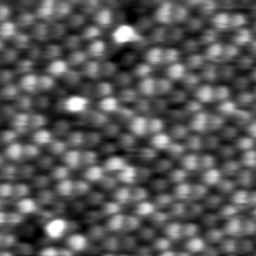Thermovoltage
Thermovoltage in scanning tunneling microscopy
If tip and sample of a scanning tunneling microscope (STM) are at different temperatures, a voltage between them can occur. This thermovoltage is similar to the well-known thermoelectric Seebeck effect: both are caused by the different broadenings of the fermi distributions and the different densities of states (DOSs) of tip and sample.
The DOS is linked to chemical properties. If the tip doesn't change during the experiment, chemically different areas of the sample can be distinguished.
The combination of chemical analysis and the high spatial resolution of the STM allows us to analyze deposited foreign atoms on a substrate or even equal atoms with different chemical bonds.


Experimental method

To avoid interference between the small (few mV) thermovoltage and a bias voltage, this STM has to operate at zero bias voltage.
A small alternating voltage is used for the height control: The alternating part of the tunneling current (upper cycle of the diagram to the right) is used for a conventional height control. This control gives us usual topographic images of constant tunneling conductance.
The thermovoltage leads to an additional constant current: The constant part of the tunneling current (lower cycle) controls a compensation voltage which keeps the average current zero. Then the internal thermovoltage equals the external compensation voltage, which can easily be measured.
